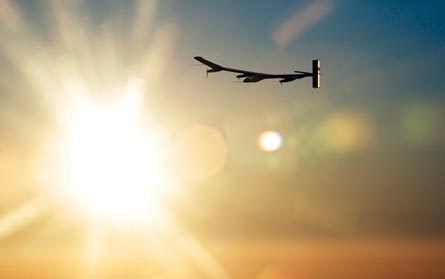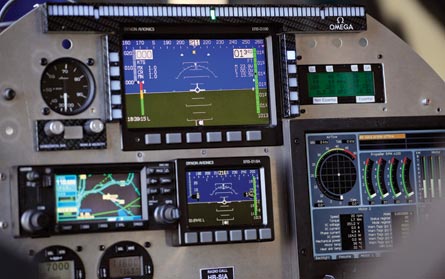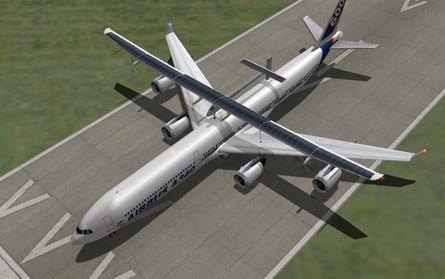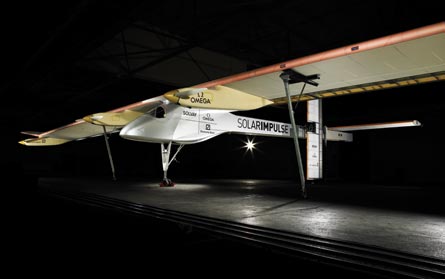Some would say it takes a brave man to fly a solar aircraft on an overnight flight. For engineer, chief engineer and Solar Impulse pilot André Borschberg, it was the highlight of a career - and the culmination of years of work.
"I've been a pilot for 40 years now, but this flight has been the most incredible one of my flying career," Borschberg says. "Just sitting there and watching the battery charge level rise and rise thanks to the Sun And then that suspense, not knowing whether we were going to manage to stay up in the air the whole night. And finally the joy of seeing the Sun rise and feeling the energy beginning to circulate in the solar panels again."
|
|---|
The Solar Impulse prototype HB-SIA spent more than 26h aloft using only the power of the Sun, travelling from Payerne air base in Switzerland over the Alps at an altitude topping off at 28,000ft (8,540m) before returning to Payerne.
The four-engined aircraft, which has a 63.4m wingspan but weighs just 1,600kg (3,525lb), is powered by 450kg of lithium ion batteries, which run the four electric motors. The wing and the horizontal stabiliser house more than 12,000 solar panels. The prototype's solar cells charged throughout the day after the early-morning take-off, gathered enough energy to power the aircraft through the night in what the team says is the longest and highest solar-powered flight by a manned aircraft ever.
Over 24h, in the best conditions, the power train delivers an average of 8hp (6kW), roughly the power used by the Wright Flyer in 1903, according to Solar Impulse project information.
|
|---|
Long-endurance flights with reduced carbon emissions and fuel consumption have long been a dream of environmentally minded engineers, although their practical uses are unclear. "Solar power is unlikely to be the solution for commercial aviation. But after today's flight, nobody, ever again, can say that carbon-free flight is impossible. The industry's job is to achieve the same for a plane carrying 400 people," says the International Air Transport Association.
The ultralight HB-SIA is made primarily of carbonfibre and carries only the pilot.
But the Solar Impulse project's next goal will edge research closer to the ultimate goal of passenger flight without burning hydrocarbons. The group is already at work on HB-SIB - a second, much larger aircraft set for completion in 2011. The new aircraft will have a pressurised cockpit, advanced avionics and environmental support for an anticipated 39,000ft cruise altitude. The 80m-wide HB-SIB will have a wingspan slightly larger than that of an Airbus A380.
|
|---|
The goal is for an around-the-world solar-powered flight in 2012, with five planned stops to swap pilots, each leg lasting for a period of three to four days.
Funding for the €58 million ($88 million) Solar Impulse project has been private, primarily coming from sponsors Deutsche Bank, Omega and Solvay. But support for the project comes from a team of more than 50 specialists and advisers from six countries, including Altran, Bayer MaterialScience, Clarins, Dassault and the European Space Agency.
SOLAR RIVALS
Solar Impulse and its supporters are not the only ones looking to take to the skies for extended periods of time without the aid of petrol.
Qinetiq is on a similar mission, although without a pilot aboard. The company's Zephyr high-altitude long-endurance (HALE) unmanned air vehicle, which holds an unofficial solar-powered endurance record at 82h 37m, is being readied for an imminent attempt at a fortnight's endurance.
"The aim is for two weeks this time, to show that we've moved out of the research phase to a product that you might buy," says HALE business manager Jon Saltmarsh.
Already flown as a 6m wingspan subscale demonstrator, the new Zephyr design weighs 53kg and has a 23m wingspan. The wing area has been increased by 50% by using a wider chord, and new winglets provide improved lift. A new T-tail configuration has also been adopted as a drag-reduction measure.
The wing houses rechargeable lithium sulphur batteries supplied by Arizona-based Sion Power. An advanced power management system allows individual batteries to be switched off to conserve energy.
|
|---|
Following a dawn hand launch by five people from a test range in Yuma, Arizona, the Zephyr will climb to around 10,000ft before its autopilot is engaged and it begins harvesting solar energy.
Three 8h shifts of a pilot, navigator and flight engineer each will monitor its battery performance and meteorological conditions for the duration of the sortie, which aims to claim the official endurance record, currently held by a 33h flight from a Northrop Grumman RQ-4 Global Hawk.
The latest flight is only part of testing from the Yuma range that is expected to last several months. Potential applications for the Zephyr could include serving as a communications relay platform in support of other UAVs, flying at altitudes above 60,000ft. Alternatively, it could carry a lightweight electro-optical/infrared sensor or electronic surveillance equipment weighing 2-3kg.
Source: Flight International



























